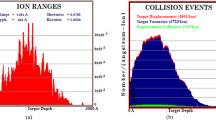Abstract
We report on the study of the characteristics of indium–tin oxide (ITO) films prepared by well-controlled and reproducible DC magnetron sputtering in argon with consequent annealing in oxygen atmosphere. The structural, electrical, and optical properties of the ITO films were investigated. It was found that the films deposited in argon atmosphere with a commercial ITO target have low transparency and high resistivity. The lower value of the resistivity around 3 × 10−4 Ω cm and the higher value of the figure of merit of 7.4 × 10−3 Ω−1 for 200 nm thick films are obtained after postannealing the films at the optimal temperature T = 300 °C for 1 h. It was found experimentally that postannealing at different temperatures allows tuning effective work function of the ITO films in the range of 4.2–5.5 eV. The latter is an important issue for applications in optoelectronic devices. The fabrication method is useful for the fabrication of ITO films with high electro-optical parameters on flexible polyimide substrates.













Similar content being viewed by others
References
W.G. Haines and R.H. Bube: Effects of heat treatment on the optical and electrical properties of indium-tin oxide films. J. Appl. Phys. 49, 304 (1978).
D. Ginley, H. Hosono, and D.C. Paine eds.: Handbook of Transparent Conductors (Springer, New York, 2011); 534p.
O. Malik, F.J. De la Hidalga-Wade, C. Zúñiga-Islas, and J.H. Abundis-Patiño: UV-sensitive optical sensors based on ITO-GaP heterojunctions. Phys. Status Solidi C 7, 1176 (2010).
O. Malik, F.J. De la Hidalga-Wade, C. Zúñiga-Islas, and G. Ruíz-T: Efficient ITO–Si solar cells and power modules fabricated with a low temperature technology: Results and perspectives. J. Non-Cryst. Solids 354, 2472 (2008).
O. Malik, A.I. Martinez, and F.J. De la Hidalga-Wade: The physical reason of intense electroluminescence in ITO–Si heterostructures. Thin Solid Films 515, 8615 (2007).
O. Malik and F.J. De la Hidalga-Wade: Spray deposited thin films of tin-doped indium oxide for optoelectronic applications. Adv. Mater. Res. 677, 173 (2013).
H. Enoki, J. Echigoya, and H. Suto: The intermediate compound in the In2O3–SnO2 system. J. Mater. Sci. 26, 4110 (1991).
W.J. Heward and D.J. Swenson: Phase equilibrium in the pseudo-binary In2O3–SnO2 system. J. Mater. Sci. 42, 7135 (2007).
G.B. González, T.O. Mason, J.S. Okasinski, T. Buslaps, and V. Honkimäki: Determination of stability of tin in indium oxide in situ and ex situ x-ray diffraction. J. Am. Ceram. Soc. 1, 1 (2011).
G. Falk: Sintering of transparent conductive oxides: From oxide ceramic powders to advanced optoelectronic materials. In Sintering of Ceramics-new Emerging Techniques, A. Lakshmanan ed.; InTech: Croatia, 2012; pp. 587–610.
T. Minami, H. Sonohara, T. Kakumu, and S. Takata: Physics of very thin ITO conducting films with high transparency prepared by DC magnetron sputtering. Thin Solid Films 270, 37 (1995).
M. Gheidari, H.H. Dabaghi, D. Kalhor, M. Iraj, M. Kazemzad, and F. Behafarid: Post annealing effects on the properties of sputtered nano-crystallite indium tin oxide thin films on flexible polyimide substrate. Phys. Status Solidi C 10, 3338 (2008).
T.A. Gessert, Y. Yoshida, C.C. Fesenmaier, and T.J. Coutts: Sputtered In2O3 and ITO films containing zirconium. J. Appl. Phys. 105, 083547 (2009).
M. Gulen, G. Yildirim, S. Bal, A. Varilci, I. Belenli, and M. Oz: Role of annealing temperature on microstructural and electro-optical properties of ITO films produced by sputtering. J. Mater. Sci.: Mater. Electron. 24, 467 (2013).
T.A. Cessert, Y. Voshida, C.C. Fesenmaier, and T.J. Coutts: High-transparency sputtered In2O3 and ITO films containing zirconium. NREL/PR-520-42307. Presented at AVS 54th International Symposium & Exhibition, October, Seattle, Washington, USA, 2007; p. 14.
C.P. Udawatte and K. Yanagisawa: Hydrothermal preparation of highly sinterable tin doped indium oxide powders: The effect of the processing parameters. In Proceedings of the 7th International Conference on Ceramic Processing Science, Inuyama, Japan, 2000; p. 46.
M. Nisha, S. Anusha, A. Antony, R. Manoj, and M.K. Jayaraj: Effect of substrate temperature on the growth of ITO films. Appl. Surf. Sci. 252, 1430 (2005).
N. Nisha: Growth and characterisation of radio frequency magnetron sputtered indium tin oxide thin films. PhD Thesis, Cochin University, Kerala, India, 2006; p. 116.
G. Haacke: New figure of merit for transparent conductors. J. Appl. Phys. 47, 4086 (1976).
H.R. Fallah, M. Ghasemi, A. Hassanzadeh, and H. Steki: The effect of annealing on structural, electrical and optical properties of nanostructured ITO films prepared by e-beam evaporation. MRS Bull. 42(3), 487 (2007).
C. Guillén and J. Herrero: Influence of oxygen in the deposition and annealing atmosphere on the characteristics of ITO thin films prepared by sputtering at room temperature. Vacuum 80, 615 (2006).
C. Viespe, I. Nicolae, C. Sima, C. Grigoriu, and R. Medianu: ITO thin films deposited by advanced pulsed laser deposition. Thin Solid Films 515, 8771 (2007).
M.A. Aouaj, R. Diaz, A. Belayachi, F. Rueda, and M. Abd-Lefdil: Comparative study of ITO and FTO thin films grown by spray pyrolysis. MRS Bull. 44(7), 1458 (2009).
M.J. Alam and D.C. Cameron: Investigation of annealing effects on sol–gel deposited indium tin oxide thin films in different atmospheres. Thin Solid Films 420–421, 76 (2002).
J. Shewchun, J. Dubow, C.W. Wilmsen, R. Singh, D. Burk, and J.F. Wager: The operation of the semiconductor-insulator-semiconductor solar cell: Experiment. J. Appl. Phys. 50, 2832 (1979).
N. Bakasybramanian and A. Subrahmanyan: Studies on evaporated indium tin oxide (ITO)/silicon junctions and an estimation of ITO work function. J. Electrochem. Soc. 138, 322 (1991).
I.D. Parker: Carrier tunneling and device characteristics in polymer light-emitting diodes. J. Appl. Phys. 75, 1656 (1994).
Y. Park, V. Choong, and Y. Gao: Work function of indium tin oxide transparent conductor measured by photoelectron spectroscopy. Appl. Phys. Lett. 68, 2699 (1996).
R. Schlaf, H. Murata, and Z.H. Kafafi: Work function measurements on indium tin oxide films. J. Electron Spectrosc. Relat. Phenom. 120, 149 (2001).
T. Ishida, H. Kobayashi, and Y. Nakato: Structures and properties of electron-beam-evaporated indium tin oxide films as studied by X-ray photoelectron spectroscopy and work-function measurements. J. Appl. Phys. 73(9), 4344 (1993).
E.H. Nicollian and J.R. Brews: MOS (Metal Oxide Semiconductor) Physics and Technology (Willey, New York, 2003); p. 468.
Y. Sato, R. Tokumaru, E. Nishimura, P. Song, and Y. Shigesato: Structural, electrical, and optical properties conductive In2O3–SnO2 films. J. Vac. Sci. Technol. A 34(4), 1167 (2005).
W. Schmid: Consumption measurements on SnO2 sensors in low and normal oxygen concentration. PhD Thesis, Eberhard-Karls-Universität, Tübingen, Baden-Württemberg, Germany, 2004; p.17.
B. Low, F. Zhu, K. Zhang, and S. Chua: Improvement of hole injection in phenyl-substituted electroluminescent devices by reduction of oxygen deficiency near the indium tin oxide surface. Appl. Phys. Lett. 80, 4659 (2002).
W. Song, S.K. So, D. Wang, Y. Qiu, and L. Cao: Angle dependent X-ray photoemission study on UV-ozone treatments of indium tin oxide. Appl. Surf. Sci. 177, 158 (2001).
M.G. Helander, Z.B. Wang, J. Qiu, M.T. Greiner, D.P. Puzzo, Z.W. Liu, and Z.H. Lu: Chlorinated indium tin oxide electrodes with high work function for organic device compatibility. Science 332, 944 (2011).
Q.Q. Yang, S-L. Zhao, Z. Xu, F.J. Zhang, G. Yan, C. Kong, X. Fan, Y-F. Zhang, and X-R. Xu: Enhanced performance in organic photovoltaic devices with a KMnO4 solution treated indium tin oxide anode modification. Chin. Phys. B 21, 128402 (2012).
ACKNOWLEDGMENTS
This work was partially supported by CONACyT-Mexico under Grant No. 102397. Authors acknowledge the technical staff at the Microelectronics Laboratory INAOE and Dr. A. Kosarev (INAOE) for constructive discussions.
Author information
Authors and Affiliations
Corresponding author
Rights and permissions
About this article
Cite this article
Malik, O., De la Hidalga-Wade, F.J. Optoelectronics properties of tin-doped indium oxide films fabricated by DC magnetron sputtering in pure argon with post-annealing in oxygen atmosphere. Journal of Materials Research 30, 1894–1901 (2015). https://doi.org/10.1557/jmr.2015.159
Received:
Accepted:
Published:
Issue Date:
DOI: https://doi.org/10.1557/jmr.2015.159




